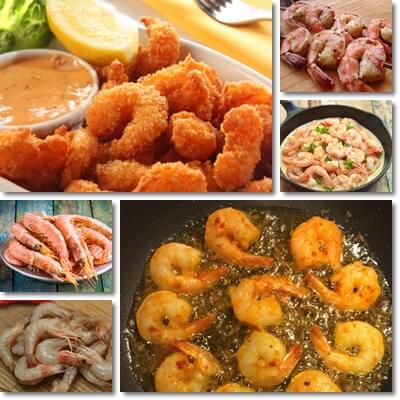Most people prefer shrimp over shellfish like oysters, clams or scallops because of their good tasting meat that doesn’t have fishy, briny or seawater flavors. Nutritionally speaking, shrimp are a great addition to many diets, providing important amounts of protein, iodine and phosphorus. When consumed in moderation, they benefit thyroid health, boost metabolism, combat brain fog and mental fatigue, physical fatigue and help maintain good bone density. However, their high sodium, cholesterol and purines content warrants moderation.
What is shrimp?
Shrimp refers to a species of small crustaceans related to lobsters, crabs and prawn. They are called crustaceans because their bodies are covered with an exoskeleton resembling a shell. Shrimp live both in saltwater and freshwater and are used as seafood for human consumption. They are either caught from the wild or originate from aquaculture, or shrimp farms.

What do shrimp eat?
Some species filter water and extract the plankton and microorganisms in the water to feed on them. Others eat algae, while some species feed on parasites and dead tissue from other marine life forms. Shrimp bear great ecological importance, cleaning water, filtering contaminants, providing sustenance for a wide range of marine animals and preserving ecosystem balance.
What does shrimp look like?
Shrimp look like bigger versions of krill (also see benefits of krill oil). They have segmented bodies covered with a shell-like exoskeleton and made up of a head with antennae, thorax, abdomen and a small tail shaped like a fan. Shrimp come in many colors, from grayish white, pink and orange to red, blue and black, with or without stripes and other color patterns and turn bright pink or orange when cooked.
What is the difference between shrimp and prawns?
Both are crustaceans and look very similar in appearance, but are different species. While the names are used interchangeably, prawn denominates a similar-looking species, but bigger than shrimp. There are also shrimp species that are as big or bigger than prawn, but they are called jumbo shrimp. Particularly big prawn species may be called jumbo prawn.
What does shrimp taste and smell like?
The reason why most people like shrimp is because the meat doesn’t have overpowering stinky fish flavors or the briny seawater taste of other shellfish or fish. Actually, shrimp tastes pleasant, similar to crab meat, with delicate sweet flavors, a mild salty taste and only a subtle smell of fresh fish. Shrimp meat has a firm, but tender texture and it almost melts in your mouth, like butter. How to tell if shrimp are cooked well? The meat should remain firm, but tender and retain the flavors described above. Around 5-7 minutes of cooking are needed. see also : Can You Eat Raw Shrimp?

How to tell if shrimp have gone bad.
Like you would tell any fish is bad. The meat and eyes should preserve a translucent, slightly glossy appearance. A dull color indicates the shrimp is not fresh. If the meat breaks into pieces when handled or feels slimy and sticky to the touch, the shrimp have gone bad. Similarly, a foul, strong fish smell, ammonia or chlorine smell means you should throw the shrimp out. Black spots on the shell mean they have started rotting. See the full article here.
The color of raw shrimp meat can be white, off white, grayish, pink, red, with various patterns like red, pink, blue, dark grey or black color tints, depending on the variety, but must preserve a fresh, translucent appearance. Is shrimp good for you? Actually, eating shrimp can be both good and bad for you. Read below the top 6 most relevant nutrition facts, health benefits and risks of eating shrimp.
Nutrition facts and health effects
1) High protein food. Whether fresh, frozen, canned or otherwise cooked, shrimp have 20 g of protein per 100 g, which amounts to roughly 40% of the recommended daily intake of protein (RDI 50 g of protein). The amino acids that make protein benefit the nervous system and help improve mood. Moreover, getting enough protein in your diet helps you lose weight, build lean muscle and recover faster from muscle injuries, making shrimp a good food for weight loss and bodybuilding.
2) Source of Omega-3. While amounts may vary immensely, shrimp are generally a good source of Omega-3 fatty acids, especially DHA, a form which benefits brain development and preserves mental health. Omega-3 fatty acids also have strong anti-inflammatory properties and bring benefits for the cardiovascular system.
3) High in cholesterol: benefits and health risks. In moderate amounts, cholesterol is an essential nutrient because it represents food for the brain, helping maintain nerve health. However, shrimp may contain 150 to 160 mg of cholesterol/100 g, easily providing more than 50% of the RDI of cholesterol (which is 300 mg). Too much cholesterol is unhealthy and can have negative effects on our health, including high cholesterol, hypertension and belly fat. It is also one of reasons shrimp are considered bad for pregnant women, especially those who are at risk of developing high blood pressure.
4) Rich in iodine. As shellfish, shrimp provide important amounts of dietary iodine. The nutrient iodine is vital for thyroid health, helping produce thyroid hormones which regulate metabolism and hormone production. A low intake from dietary sources causes hypothyroidism with symptoms such as slow metabolism, weight gain, mental and physical fatigue, mental fog, depression and mental retardation in babies and young children. Hypothyroidism also negatively impacts female fertility and reduces pregnancy chances. At least from this point of view, shrimp, crab, oysters and other shellfish are good for your health.
5) Source of phosphorus. 100 g of shrimp contains around 200 mg of phosphorus out of the 1,250 mg RDI for an average adult on a 2,000 kcal diet. Phosphorus is vital for good bone density, contributing to stronger bones and teeth.
6) High sodium content. Shrimp may contain 200 to 900 mg of sodium/100 g.
The RDI of sodium is 2,300 mg a day for the average adult.
100 g of shrimp provides between 10% to 40% the RDI of sodium.
Too much sodium increases the risk for water retention, high blood pressure and cardiovascular events.
The high sodium content of shrimp is also a reason they are not recommended in pregnancy or to hypertension sufferers.
Below is an interesting video showing how shrimp is harvested on the Gulf Coast of the United States and some of the realities behind the shrimp industry as seen by small, family businesses that strive to offer quality and meet sustainability standards.
From a nutritional point of view, shrimp is both good and bad for you. But in addition to this, it carries other risks. Here are the 2 major health risks associated with eating shrimp:
1) Food poisoning due to contaminants and toxins. Some shrimp are filter feeders, meaning they filter water to get their food. But seawater in particular also has many contaminants and toxins which they ingest and pass on to humans. Aluminum, toxins from algae overgrowth, bacteria like E. coli or Salmonella, antibiotics from fish farms can all cause food poisoning and other health problems in humans. So make sure you check where you shrimp comes from and eat in moderation. If you experience abdominal pain, diarrhea, nausea, vomiting or other symptoms after eating shellfish, see a doctor immediately.
2) Shrimp allergy. Shrimp is a common food allergen along with other shellfish. If you have known allergies, refrain from eating shrimp. Seek medical help immediately if you experience the following symptoms after eating shrimp: skin rash, itching, tingling tongue, face or tongue swelling, trouble breathing, sudden drop in blood pressure, dizziness or fainting sensation. These are signs of an allergic reaction and can culminate with life-threatening anaphylactic shock.
